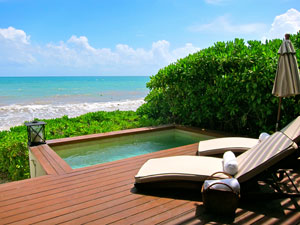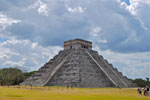BY LINDSAY TAUB
If asked to name a handful of countries aggressively taking steps to solve climate change, would Mexico come to mind? Probably not. But it should. Here’s why.
Although Mexico may be keeping many tourists wary of visiting amid headlines reporting increasing crime, there’s a silver lining not being widely reported. The country is beginning to be recognized globally for its commitment to tackling climate change. In fact, it was Mexico that led international efforts towards a successful COP 16, which took place in Cancun in November 2010. And in May 2011, Mexico was honored by the Rainforest Alliance for its commitment to forestry and sustainable tourism development.
The Mexico Tourism Board is a not only a member of the Global Sustainable Tourism Council, but it was the Mexico Tourism Board’s Regional Director for North America, Alfonso Sumano, who was part of the founding group. In Mexico’s tourism sector, members of the federal and local government as well as the private sector have been practicing a number of sustainable practices for many years.
 That’s just the beginning. Various tourist destinations and businesses in Mexico are implementing sustainable tourism initiatives, not just because it’s smart commerce, but as a culture so immersed in their natural world, it feels right – a responsibility to protect their most precious trusted resource – the nature itself.
That’s just the beginning. Various tourist destinations and businesses in Mexico are implementing sustainable tourism initiatives, not just because it’s smart commerce, but as a culture so immersed in their natural world, it feels right – a responsibility to protect their most precious trusted resource – the nature itself.
One example is Huatulco, the first destination in the world to receive Earth Check’s Gold certification. Previously, EarthCheck Gold certification was awarded only to hotel and resort facilities, and not entire destinations.
Another is Rosewood’s Mayakoba, an award-winning five-star luxury resort in Riviera Maya on the Yucatan peninsula and a shining example for eco-friendly resorts around the globe. The resort received awards from the World Tourism Organization (Ulysses 2011 Award) and Rainforest Alliance (Sustainable Standard-Setter Award) for its commitment to sustainability, improvement of the environment, sustainable tourism and support of local communities. The Rainforest Alliance is an organization committed to alleviating critical environmental and social issues by championing standards that promote the sustainable use of resources and conserve the planet’s biodiversity.
Need proof green can be luxurious?
Rosewood Mayakobá sits in the heart of a 1600-acre resort enclave in the Riviera Maya. Built along winding lagoons and a mile long arc of pristine beach along the Caribbean Sea, the oasis of indulgence offers 128 suites (ranging from 800 to 3,200 square feet).
Suites feature private plunge pools, rooftop sundecks, rain style outdoor showers, and exquisite décor paired with superior room amenities. Upon arrival, guests are transported by luxury boat or golf cart to their doorstep and welcomed to their suite by a private butler. The 17,000-square-foot Sense, A Rosewood Spa, sits on a private island and is designed around a cenote, one of the sacred water wells of the ancient Mayans who considered the natural sinkholes to be the entrance to the underworld.
superior room amenities. Upon arrival, guests are transported by luxury boat or golf cart to their doorstep and welcomed to their suite by a private butler. The 17,000-square-foot Sense, A Rosewood Spa, sits on a private island and is designed around a cenote, one of the sacred water wells of the ancient Mayans who considered the natural sinkholes to be the entrance to the underworld.
“Rosewood Mayakobá prides itself on leading by example when it comes to environmental efforts,” said Regional Vice President and Managing Director of Rosewood Mayakobá, Pablo Graf. “We strive to provide our guests an unparalleled experience, but do so without sacrificing the environment and its natural resources.”
As part of the RA program Rosewood Mayakobá, also a LEED Silver certified resort, was judged on the purchase of environmentally friendly products, use of local and fair-trade services and goods, preservation of native wildlife and landscaping and the protection of local historic properties and sites.
Another shining example among the sustainability stars in Mexico is the Sandos Caracol Eco Resort & Spa, located in Mayan jungle and surrounded by cenotes, mangroves and lagoons.
 Their Royal Elite Ocean View room is part of a renovated section of ecologically responsible rooms that feature ultra-efficient air conditioning systems with low power consumption, solar-heated water, internal LED lighting systems, an internal water recycling system, and furniture made solely with wood from certified forests.
Their Royal Elite Ocean View room is part of a renovated section of ecologically responsible rooms that feature ultra-efficient air conditioning systems with low power consumption, solar-heated water, internal LED lighting systems, an internal water recycling system, and furniture made solely with wood from certified forests.
The resort also features eco-activities for kids focused on teaching them “to live in harmony with nature, to take care of the environment and to learn about the plants and animals of the region.”
Eco-tours are also cropping up all over the most popular destinations as well, such as the company alltournative which offers sustainable activities in the Yucatan. They work closely with the Mayan communities to ensure authentic, minimal impact fun is provided to visitors without damaging the environment or leaving a so-called footprint.
Need more?
Xel-Há
is a sustainable, all-inclusive park in the Riviera Maya. It covers 70 hectares on land, containing five different ecosystems, and 14 hectares of water forming the Mexican Caribbean’s most spectacular inlet. Because of its unique characteristics, Xel-Há has become a natural refuge for over 400 species of plants, birds and fish.
different ecosystems, and 14 hectares of water forming the Mexican Caribbean’s most spectacular inlet. Because of its unique characteristics, Xel-Há has become a natural refuge for over 400 species of plants, birds and fish.
This idyllic place is considered one of Mexico’s Natural Wonders and is the perfect spot for a huge number of activities in contact with nature, in addition, of course, to being the best place to go snorkeling.
By the numbers:
- Mexico is home to more than 100,000 monuments built between the sixteenth and the nineteenth centuries, and about 300,000 archeological sites with 173 open to the public.
- Mexico has 174 protected natural areas covering 13 percent of the Mexican territory. Of those, 40 are Biosphere Reserves that cover 6.5 percent of the territory.
- Thirty-one places have been recognized by UNESCO as World Heritage sites because of their cultural, natural or mixed landmarks.
- Alongside these physical places Mexico’s cuisine has been granted World Heritage status by UNESCO and only in the last year has the cultural significance of Mexico’s Mariachi music been recognized in the same way.
As a result, Mexico developed Magical Towns, a program that has been able to convert culturally rich towns into visitor-friendly destinations through the help of funds from local, state and federal efforts. The program has attracted tourists and improved the lives of locals living in cities across Mexico.
 If looking to plan your next getaway, aside from supporting the green movement happening in Mexico, there are many areas that are indeed safe, open for business, and as gorgeous as they come. Of course being mindful and smart about your belongings and wanderings is always advised no matter where you go in the world.
If looking to plan your next getaway, aside from supporting the green movement happening in Mexico, there are many areas that are indeed safe, open for business, and as gorgeous as they come. Of course being mindful and smart about your belongings and wanderings is always advised no matter where you go in the world.
Lindsay Taub is an award-winning freelance journalist who covers travel, lifestyle, culture, arts, food, health, and all facets that make life a journey. Learn more at lindsaytaub.com and follow her on Twitter @lindsaytaub58.






[…] Keep reading in Green Living magazine here. […]
[…] The Luxurious and Green Mexico — Green Living Magazine […]